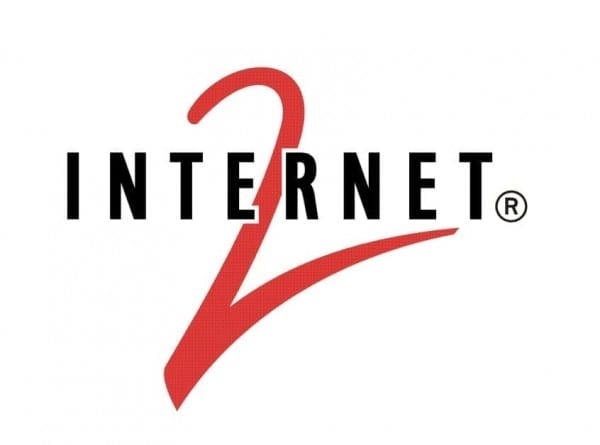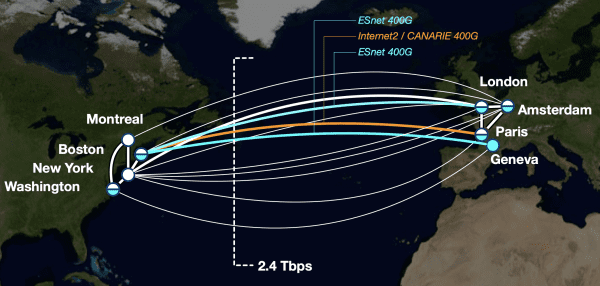Internet2, ESnet, CANARIE and GÉANT Unveil Highest Capacity Transoceanic Connectivity for Research and Education
Internet2, in a joint effort with CANARIE, the Energy Sciences Network (ESnet), and GÉANT, recently announced a major expansion of 400 gigabits per second (Gbps) transoceanic circuit capacity dedicated to transferring research and education (R&E) data. As part of the Advanced North Atlantic (ANA) collaboration, this marks a significant achievement in high-speed connectivity between North America and Europe, supporting data-intensive science globally.
ANA’s network expansion supports multinational, data-intensive science collaborations, including the Large Hadron Collider (LHC), the world’s largest and most powerful particle accelerator, and the Square Kilometer Array (SKA), the ongoing effort to build the world’s largest radio astronomy observatory. It adds much-needed capacity for transmitting instrument findings to researchers globally, enabling ground-breaking discoveries.
“The University of Oklahoma is an ATLAS Tier2 computing center for the LHC experiment at CERN,” OU research scientist Horst Severini, Ph.D., said. “OU is using all four of these networks for ATLAS data transfers from OU to our ATLAS collaborators in Canada and Europe, so we’re looking forward to making use of this new bandwidth increase!”
Record-Breaking Cable System
The joint effort adds three 400 Gbps spectrum circuits between exchange points in the U.S., U.K., and France. The new connections utilize the record-breaking 400 terabits per second (Tbps) trans-Atlantic Amitié subsea cable system completed in July 2023, which spans 6,783 kilometers (4,215 miles). The flexibility and scalability of these spectrum circuits enable significant capacity growth on the same infrastructure, achieved through future equipment upgrades at exchange points.
The collaboration among Internet2, ESnet, CANARIE and GÉANT to leverage the new subsea infrastructure started in 2020, following an R&E community-driven proposal to modernize and augment intercontinental connectivity to support research. It culminated after a years-long process of technical planning, acquisition, and deployment.
As a result, the global R&E network fabric gains critical capacity and resiliency between North America and Europe. With the addition of the new circuits, the combined capacity of the ANA collaboration’s trans-Atlantic network is now 2.4 Tbps.
International Collaboration for Intercontinental Connectivity
ESnet will operate two of the 400 Gbps transoceanic circuits in support of U.S. Department of Energy national laboratories, supercomputing facilities, major scientific instruments, and global collaborators, bringing its total 400 Gbps transoceanic circuits to three. Internet2 will operate one circuit for members of the U.S. R&E community, as well as its North American partner CANARIE.
To support these new connections and other emerging capacity needs for data-intensive science in the U.S. and internationally, Internet2 recently bolstered its global exchange points on the East Coast. That included adding a new 400 Gbps exchange point in Boston, MA. Internet2 also augmented two existing exchange points with 400 Gbps switching capacity: the Manhattan Landing (MAN-LAN) in New York, NY, and the Washington International Exchange (WIX) in McLean, VA. With the project’s completion, Internet2 is among the first R&E networks to operate 400 Gbps global exchange points.
From the endpoints of the Amitié cable systems in the U.K. and France, GÉANT is providing the connectivity to deliver the trans-Atlantic traffic to the London, Geneva, and Paris points of presence on its pan-European network backbone. Looking ahead, GÉANT is also planning to further reinforce the ANA collaboration’s capacity by upgrading its trans-Atlantic connectivity via the GN5-IC1 project, in response to the rapidly growing needs of data-intensive research collaborations between Europe and North America.
Empowering Research in Oklahoma
“This expanded capacity across the Atlantic continues to empower Oklahoma researchers, educators, and students with the high-speed connectivity they need to meet their scientific and academic goals,” said James Deaton, vice president of Network Services at Internet2.
“From researchers leveraging the experimental data of the Large Hadron Collider to universities sharing data repositories with collaborators across the dozens of nations served by these links — Oklahomans benefit from OneNet’s world-class network and its interconnection with the global fabric of research and education networks.”
Oklahoma researchers have access to this new capacity thanks to OneNet’s connection to Internet2, a nonprofit, member-driven advanced technology community founded by U.S. leading higher education institutions in 1996. Internet2 delivers a diverse portfolio of technology solutions that leverages, integrates, and amplifies the strengths of its members and helps support their educational, research, and community service missions. Internet2’s core infrastructure components include the largest and fastest research and education network in the U.S. that was built to deliver advanced, customized services that are accessed and secured by the community-developed trust and identity framework.
“As Oklahoma’s partner in research and education, OneNet provides access to this high-capacity transoceanic connectivity for our state’s institutions through our membership in Internet2,” said Brian Burkhart, chief technology officer. “These advancements in connectivity enable our state to participate in worldwide research initiatives that ignite scientific discovery at the global level.”
Read more about OneNet’s partners in research initiatives!


